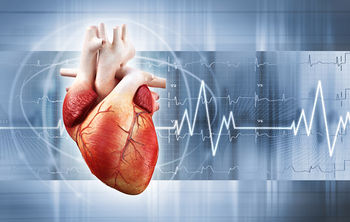Angina pectoris
Angina pectoris, often referred to as angina, occurs when the oxygen supply or nutrient supply to the heart muscle is inadequate to meet the demands. Angina is typically described as a squeezing or pressure like pain in the chest precipitated by factors such as exertion, emotional stress, or exposure to cold.[1] Angina is often relieved by rest, but may also require medication.
|
Angina Pectoris | |
| Causes | Dietary Factors, Smoking, Stress, Breathing Disorders |
|---|---|
| See Also | Cardiovascular Conditions, Hypertension, Atherosclerosis, Hypercholestemia |
| Books | Books on Cardiovascular Conditions |
| Articles | Articles on Cardiovascular Conditions |
Naturopathic Assessment
The assessment of Angina pectoris is commonly based on a person's history and on a physical exam. Since there are many causes of chest pain the first task of a naturopathic doctor or any other primary care physician is to rule out life threatening conditions.[2]
Causal Factors
In order to stimulate the innate ability of the body to heal the causes of disease must be identified and addressed. A detailed assessment is required to determine which factors are contributing to the angina symptoms and to determine the risk of more serious conditions such as a heart attack.
Lifestyle
| Check out this book | The Anti-Inflammation Diet and Recipe Book: Protect Yourself and Your Family From Heart Disease, Arthritis, Diabetes, Allergies - and More |
|---|
- Large meals can increase the risk.[3]
- Moderate to heavy exercise or activity level may be implicated as a risk for angina in those with a positive family history.[4]
- Postural misalignment of the upper thoracic can increase the susceptibility to angina.[5][6]
Physiology
- Breathing pattern disorders such as hyperventilation has been found to trigger angina attacks.[5]
- Up to 90% of non-cardiac related chest pain stems from breathing pattern disorders. Chest pain of this nature typically presents itself as angina that lasts for hours rather than minutes. In addition, it is usually relieved upon mild exertion rather than exacerbated. Breathing pattern disorders can provoke existing cardiovascular conditions as a result of its vasoconstrictive effect on the smooth muscle of the body (including cardiovascular) leading to a possible blockage and subsequent damage to the heart.[7]
Social
Environmental
- Temperatures
- Cold weather causes the blood vessels to constrict and can result in an increase in frequency of angina attacks in the winter months.[3]
Medical Interventions
- Prescription Medications
- Thyroid medications, among others may exacerbate angina.
Genetics
- Family history appears to be a factor in predicting the risk of angina.[4]
Diagnostic Testing
The diagnosis of angina is often made based on the presenting symptoms. To confirm an angina attack, to determine the severity of the condition and to rule out other conditions the following diagnostic tests are typically performed:
- Vitals are essential including; blood pressure, pulse rate and respiration rate.
- Blood tests: Creatine Kinase-MB, troponin-I, lactate dehydrogenase, cholesterol panel including apolipoprotein B and/or homocysteine.[2], [8]
- Other tests: ECG/EKG, chest X-ray, stress test or 24-hour Holter monitor.[2]
Related Symptoms and Conditions
The symptoms of angina are close to those of a panic attack and heartburn. It is common for people to confuse them. If in doubt it is always best to be checked out by your naturopathic doctor or other health care provider.[3]
It is common for angina to be associated with or to mimic other conditions such as:[3]
- Hypertension
- Atherosclerosis
- Hypercholestemia
- Coronary artery spasms
- Myocardial infarction
- Anemia may trigger symptoms of angina pectoris, intermittent claudication or transient ischemic attacks of the brain due to the lack of oxygen circulating in an individual with pre-existing cardiovascular disease.[9]
Characteristics
The symptoms of angina include:
- Squeezing or pressure-like pain in the chest immediately after exertion. [3]
- Pain may radiate to the left shoulder blade, left arm or jaw. [3] but is most commonly felt beneath the sternum. [1]
- Pain typically lasts 1 to 20 minutes. [2]
Angina is classified as:
- Stable angina refers to angina where the symptoms are consistent and dissipate quickly at rest.[8]
- Unstable angina. If the symptoms change or increase in intensity or duration than the classification changes from stable angina to unstable angina.[1] Unstable angina is also sometimes referred to as acute coronary insufficiency, preinfarction angina, or intermediate syndrome. 30% of patients with unstable angina will suffer Myocardial infarction within 3 months of onset.[1]
- Variant or Prinzmetal’s angina is secondary to large vessel spasm and pain will occur at rest and ECG results show ST elevation instead of depression.[1]
Naturopathic Treatment
The goal of naturopathic treatment is to support and work in tandem with the healing power of the body and to address the causal factors of disease with individual treatment strategies. Angina pectoris is typically an acute serious condition resulting from an underlying chronic disease that requires careful treatment and monitoring. Referral for other medical treatment may be necessary. The two main primary therapeutic goals are to improve energy metabolism within the heart and to improve blood supply to the heart. [10] It is important to address underlying Hypertension, Diabetes, or Obesity concerns if applicable.[2]
It is always advisable to work with a naturopathic doctor before engaging in any treatment plan.
Lifestyle
Lifestyle recommendations include:
- Quitting smoking is strongly recommended.[2]
- Dietary recommendations include reducing alcohol and coffee consumption.[2]
- Increase fiber, onions, garlic, vegetables and fish.[2]
- Decrease saturated fats, cholesterol, sugar and other animal-based proteins. Avoid fried foods.[2] Overall a change in fat ratio is desired with emphasis on monounsaturated fats.[8]
- Avoid food allergens and food intolerances.[2]
- Stabilize blood sugar.[10]
- Reduce simple carbohydrates that lead to adipose tissue.[8]
- Ensure that you drink adequate water.
- Decreasing stress[8], progressive relaxation, biofeedback[8], meditation or guided imagery have been known to be beneficial.[2]
- Stress reduction through relaxation, yoga, qi gong, and behavioural therapy.[2]
Naturopathic Therapies
The prescribing of naturopathic therapies requires the guidance of a naturopathic doctor as it depends on a number of factors including the causal factors, a person's age, prescription medications, other conditions and symptoms and overall health. It is always advisable to work with a naturopathic doctor prior to taking any natural therapies.
Naturopathic Therapies for angina include:
- Clinical Nutritional Supplementation includes
- Vitamins such as Vitamin E[8], vitamin B3, Folic Acid, vitamin C, vitamin B5, vitamin B6, vitamin B12[8],
- Minerals such as magnesium, calcium, chromium[10] [2]
- Amino Acids such as Arginine, Taurine
- Other supplements: Omega-3 Fatty Acids, Coenzyme Q10[2], L-Carnitine[2], Pantethine, Policosanol, Flaxseed oil[8], Fish oil[8], astraxanthin, lycopene, bioflavonoids.
- Herbs such as Hawthorn (Crataegus monogyna)[10], [2], Astragalus (Astragalus membranaceus)[11], Ammi visnaga a member of the carrot family acts similar to calcium channel blockers by vasodilating and reducing blood pressure.[2] Garlic (Allium sativum) fresh or standardized extract.[8], Arjuna (Terminalia arjuna)[12]
- Other botanicals are often prescribed to treat other underlying conditions, such as hypercholestemia or Atherosclerosis
Gemmotherapies such as Ligustrum vulgare, Syringa vulgaris
- Homeopathy such as: Aconitum nap[8], Belladonna, Lycopodium, Bellis, Spigelia[8], Naja[8], Glonoine[8], Selenicerus grandiflorus(Cactus)[8].
- Traditional Chinese Medicine & Acupuncture
- Differentials to consider include general conditions such as; qi and blood stagnation, blood and phlegm stagnation, blood deficiency.[13].
- Specific organ pathologies to consider include; heart qi deficiency and heart yang deficiency.[13]
- Acupuncture points to consider include; PC6, UB14, ST40, UB13, LU9, ST22 or ashi near ST22, LI3, SP6, LR5 or ashi near LR5, LU11, PC9, HT9, ST36, GB34, UB40, LI4, TW3, SI3, LR4, KD3.[13]
Specialized Naturopathic Therapies
Specialized therapies that are used to treat anemia include:
- Intravenous Therapies such as EDTA chelation, IV Magnesium chloride or Magnesium sulfate, Myers' cocktail.
References
Reviewed by Iva Lloyd, BScH, RPE, ND [1]
- ↑ 1.0 1.1 1.2 1.3 1.4 Berga S, Bowman M, Drossman D, Faling J, Frenkel E, Gabbard G et al. (1992) The Merck Manual of Diagnosis and therapy 16th edition. Rathway: Merck & Co Inc.
- ↑ 2.00 2.01 2.02 2.03 2.04 2.05 2.06 2.07 2.08 2.09 2.10 2.11 2.12 2.13 2.14 2.15 2.16 2.17 El-Hashemy Shehab (2007) Naturopathic Standards of Primary Care CCNM Press Inc.
- ↑ 3.0 3.1 3.2 3.3 3.4 3.5 3.6 3.7 3.8 Mulvihill, Selman, Holdaway, Tompary, Raymond editors (2006) Human Diseases – A Systemic Approach 6th ed. Pearson Educatin Inc.
- ↑ 4.0 4.1 4.2 Merry AH, Boer JM, Schouten LJ, Feskens EJ, Verschuren WM, Gorgels AP, van den Brandt PA (2011) Smoking, alcohol consumption, physical activity, and family history and the risks of acute myocardial infarction and unstable angina pectoris: a prospective cohort study. BMC Cardiovasc Disord;11:13. PMID:21435252.
- ↑ 5.0 5.1 Chaitow, L, Bradley, D, and Gilbert, C (2002) Multidisciplinary Approaches To Breathing Pattern Disorders Churchill Livingstone
- ↑ Christensen HW, Vach W, Gichangi A, Manniche C, Haghfelt T, Høilund-Carlsen PF(2005) Cervicothoracic angina identified by case history and palpation findings in patients with stable angina pectoris. J Manipulative Physiol Ther.;28(5):303-11.PMID:15965404
- ↑ http://emedicine.medscape.com/article/807277-overview
- ↑ 8.00 8.01 8.02 8.03 8.04 8.05 8.06 8.07 8.08 8.09 8.10 8.11 8.12 8.13 8.14 8.15 Smith Fraser, Winterstein James(2008) An Introduction to Principles & Practices of Naturopathic Medicine CCNM Press Inc., Toronto:pg116-131
- ↑ Goldman editor. Goldman’s Cecil Medicine, 24th ed. [internet]. Saunders; (2011) Chapter 161 Approach to the Anemias. [cited 2012 Jan]. Available from: http://www.mdconsult.com.ezproxy.ndnet.ca/books/page.do?eid=4-u1.0-B978-1-4377-1604-7..00161-5&isbn=978-1-4377-1604-7&uniqId=311433323-4#4-u1.0-B978-1-4377-1604-7..00161-5
- ↑ 10.0 10.1 10.2 10.3 10.4 Pizzorno Joseph, Murray Michael, Joiner-Bey Herb (2002) The Clinician's Handbook of Natural Medicine Churchill Livingstone.
- ↑ Bone, K and Morgan, M (1999) Astragalus membranaceus - Astragalus MediHerb.
- ↑ Bharani A, Ganguli A, Mathur LK, Jamra Y, Raman PG (2002) Efficacy of Terminalia arjuna in chronic stable angina: A double-blind, placebo-controlled, crossover study comparing Terminalia arjuna with isosorbide mononitrate. Indian Heart Journal;54:170-175.
- ↑ 13.0 13.1 13.2 Kuoch David(2011) Acupuncture Desk Reference. 2nd ed. Acumedwest Inc.:pg290-307

